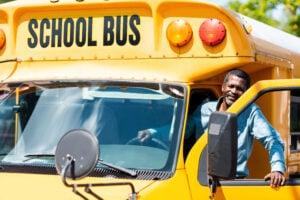School transportation pain points in 2022
Our State of School Transportation 2022 Report zeroes in on many of the paint points school administrators and student transportation professionals are experiencing today. While survey respondents mentioned many frustrations, we wanted to zoom in on a few specific pain points that respondents indicated are posing major challenges for school transportation operations.
Bus driver shortage

To nobody’s surprise, nearly eight out of ten (77.61%) State of School Transportation survey respondents reported that the ongoing bus driver shortage is having a negative impact on school district transportation operations.
Of course, the bus driver shortage is well-documented — and it began long before the onset of the coronavirus pandemic. In fact, a 2016 survey conducted by the National Association of Pupil Transportation revealed that 70% of school transportation professionals believed the shortage was getting worse even then.
Today, concerns about the pandemic — and the changing economic landscape — have only exacerbated the lack of school bus drivers on the road.
Nearly 90% (88%, to be exact) of respondents to HopSkipDrive’s survey reported that the bus driver shortage has constrained their school transportation operations. And nearly 30% of all respondents labeled those constraints as “severe.”
The top five reasons for school bus driver shortages, according to respondents? Recruiting issues, low driver pay, drivers retiring, COVID-19 concerns and losing drivers to the private sector.
The bus driver shortage has real-life consequences that affect students and education professionals, too.
“Due to lack of drivers, routes can be long with students on the bus for over an hour, and buses are overcrowded,” said one anonymous respondent to our 2021 survey.
Related: The ongoing impacts of school bus driver shortages
COVID-19 related issues
COVID-19 has worsened the bus driver shortage, especially because traditionally, bus drivers have been retirees. These older transportation professionals, who are at higher risk of complications from COVID-19, are now more likely to stop driving school buses due to fear of exposure.
Nearly 63% of respondents to our 2022 State of School Transportation survey noted pandemic-related issues as a top pain point. Taylor Perrington Ashley, a supervisor of transportation, agreed. “There is also a fear of COVID and other related illnesses that are causing older retired people who would have normally wanted to drive for us to withhold from applying,” she said.
Another anonymous respondent also lamented the effects of COVID-19 on student transportation. “We are still dealing with residual effects from COVID-19 and some budgetary issues that are causing some overcrowding on buses,” the respondent said.
Routing difficulties
Another common pain point? Routing difficulties, which are reported to negatively impact transportation operations for nearly 23% of respondents.
Trudy Foster, a transportation director, chimed in on this all-too-common problem. “As is the case with all districts,” she said, “we are faced with the daily challenge of covering all the routes.”
Of course, routing challenges can disproportionately affect the most vulnerable of students.
“Our students with special needs have the lowest attendance as a result of transportation issues. With the school bus driver shortage, if a bus route is not running, the students do not have a way to attend school. It is so inequitable,” said one anonymous respondent.
Planning transportation for each student
Many respondents also mentioned just how difficult it is to plan transportation to meet individual student needs. Transportation logistics can be especially complicated for students with special needs or students who live in rural areas — many of whom require consistent, reliable transportation in order to access the education they deserve.
“Students who rely on cab transportation, such as our homeless students, are frequently late or absent,” said one respondent.
Another respondent agreed: “Students who have poor transportation access often miss chunks of instruction during their day, or can’t participate in extracurricular activities due to transportation barriers.”
This is one reason why more and more schools are choosing alternative transportation solutions: to ensure underserved students have safe, steady transportation to and from school and extracurricular activities.
Over 53% of State of School Transportation 2022 survey respondents reported their district uses alternative school transportation solutions. These solutions are most often utilized for special education students (56%), McKinney-Vento students (54%) and students in foster care (36%).
Though the logistics of school transportation are evolving and becoming more complicated in some ways, it’s not all about the pain points for school transportation staff. Survey respondents were quick to applaud the resiliency and tenacity of transportation staff, teachers and other school and district employees.
“It has really shown us the team spirit that we have within our school district and community,” said one respondent.


